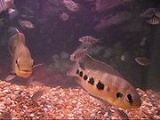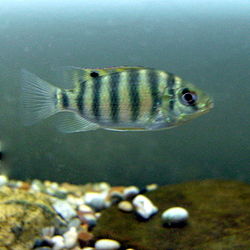
Spotted tilapia
Encyclopedia
The spotted tilapia is a West Africa
n fresh
and brackish water fish
of the cichlid
family7. It is also commonly known as the spotted mangrove cichlid or black mangrove cichlid. Spotted mangrove cichlids have a short rounded snout and three anal spines1. They are dark olive green to light yellowish in colour and have eight or nine dark bars on their sides which are more evident in young spotted mangrove cichlids than adults1. They also have two to six dark spots between the bars on the middle of their side1 and they generally reach a maximum length of 300mm3. Spotted mangrove cichlids have a rapid growth rate and maturation time3. They also have high fecundity, simple food requirements and extensive tolerance of environmental variables such as water temperature, salinity, and pollution3. These characteristics allow spotted mangrove cichlids to rapidly populate many areas that have an appropriate habitat. Typically spotted mangrove cichlids tend to be an aggressive and territorial species3 and research has found that internal reproductive androgenic factors can overrule the effect of size on dominance encounters in this species6.
from the Côte d'Ivoire
to Ghana
, and Benin
to Cameroon
. They have also established large feral populations outside of their native ranges, such as in Florida
and Australia. Spotted mangrove cichlids live in a variety of habitats. They have been found in both still and flowing waters, in shallow and deep water, in places where there is both little or no coverage and in rocky and debris-strewn areas3.
Spotted mangrove cichlids are quite common and are found in rivers near the coasts of Africa, near the Côte d'Ivoire
.
 Spotted mangrove cichlids are monogamous fish who engage in biparental care, and research has found that the size of the eggs tend to increase with the amount of parental care4. The males and females both have very specific roles in parenting and work together to ensure the well being of their offspring. The females prepare the nest by clearing an area on rocky substrate2. After spawning, the females take care of all embryo tending while males stay about two to three meters away and remain mostly inactive except for an occasional feeding or chasing away of predators2. When the offspring become two to three days old they rise off the nest and form a school. This causes a dramatic change in parental role as the male becomes active and the female begins to spend more time away from the young, guarding ahead of the school by chasing away predators2. Parental care continues until the fish are about 2.5-3cm1. This biparental behaviour could help explain why black mangrove cichlids are able to live in many different habitats and become dominant over other fish populations in the same area2.
Spotted mangrove cichlids are monogamous fish who engage in biparental care, and research has found that the size of the eggs tend to increase with the amount of parental care4. The males and females both have very specific roles in parenting and work together to ensure the well being of their offspring. The females prepare the nest by clearing an area on rocky substrate2. After spawning, the females take care of all embryo tending while males stay about two to three meters away and remain mostly inactive except for an occasional feeding or chasing away of predators2. When the offspring become two to three days old they rise off the nest and form a school. This causes a dramatic change in parental role as the male becomes active and the female begins to spend more time away from the young, guarding ahead of the school by chasing away predators2. Parental care continues until the fish are about 2.5-3cm1. This biparental behaviour could help explain why black mangrove cichlids are able to live in many different habitats and become dominant over other fish populations in the same area2.
West Africa
West Africa or Western Africa is the westernmost region of the African continent. Geopolitically, the UN definition of Western Africa includes the following 16 countries and an area of approximately 5 million square km:-Flags of West Africa:...
n fresh
Freshwater
Fresh water is naturally occurring water on the Earth's surface in ice sheets, ice caps, glaciers, bogs, ponds, lakes, rivers and streams, and underground as groundwater in aquifers and underground streams. Fresh water is generally characterized by having low concentrations of dissolved salts and...
and brackish water fish
Fish
Fish are a paraphyletic group of organisms that consist of all gill-bearing aquatic vertebrate animals that lack limbs with digits. Included in this definition are the living hagfish, lampreys, and cartilaginous and bony fish, as well as various extinct related groups...
of the cichlid
Cichlid
Cichlids are fishes from the family Cichlidae in the order Perciformes. Cichlids are members of a group known as the Labroidei along with the wrasses , damselfish , and surfperches . This family is both large and diverse. At least 1,300 species have been scientifically described, making it one of...
family7. It is also commonly known as the spotted mangrove cichlid or black mangrove cichlid. Spotted mangrove cichlids have a short rounded snout and three anal spines1. They are dark olive green to light yellowish in colour and have eight or nine dark bars on their sides which are more evident in young spotted mangrove cichlids than adults1. They also have two to six dark spots between the bars on the middle of their side1 and they generally reach a maximum length of 300mm3. Spotted mangrove cichlids have a rapid growth rate and maturation time3. They also have high fecundity, simple food requirements and extensive tolerance of environmental variables such as water temperature, salinity, and pollution3. These characteristics allow spotted mangrove cichlids to rapidly populate many areas that have an appropriate habitat. Typically spotted mangrove cichlids tend to be an aggressive and territorial species3 and research has found that internal reproductive androgenic factors can overrule the effect of size on dominance encounters in this species6.
Habitat
Spotted mangrove cichlids are native to AfricaAfrica
Africa is the world's second largest and second most populous continent, after Asia. At about 30.2 million km² including adjacent islands, it covers 6% of the Earth's total surface area and 20.4% of the total land area...
from the Côte d'Ivoire
Côte d'Ivoire
The Republic of Côte d'Ivoire or Ivory Coast is a country in West Africa. It has an area of , and borders the countries Liberia, Guinea, Mali, Burkina Faso and Ghana; its southern boundary is along the Gulf of Guinea. The country's population was 15,366,672 in 1998 and was estimated to be...
to Ghana
Ghana
Ghana , officially the Republic of Ghana, is a country located in West Africa. It is bordered by Côte d'Ivoire to the west, Burkina Faso to the north, Togo to the east, and the Gulf of Guinea to the south...
, and Benin
Benin
Benin , officially the Republic of Benin, is a country in West Africa. It borders Togo to the west, Nigeria to the east and Burkina Faso and Niger to the north. Its small southern coastline on the Bight of Benin is where a majority of the population is located...
to Cameroon
Cameroon
Cameroon, officially the Republic of Cameroon , is a country in west Central Africa. It is bordered by Nigeria to the west; Chad to the northeast; the Central African Republic to the east; and Equatorial Guinea, Gabon, and the Republic of the Congo to the south. Cameroon's coastline lies on the...
. They have also established large feral populations outside of their native ranges, such as in Florida
Florida
Florida is a state in the southeastern United States, located on the nation's Atlantic and Gulf coasts. It is bordered to the west by the Gulf of Mexico, to the north by Alabama and Georgia and to the east by the Atlantic Ocean. With a population of 18,801,310 as measured by the 2010 census, it...
and Australia. Spotted mangrove cichlids live in a variety of habitats. They have been found in both still and flowing waters, in shallow and deep water, in places where there is both little or no coverage and in rocky and debris-strewn areas3.
Spotted mangrove cichlids are quite common and are found in rivers near the coasts of Africa, near the Côte d'Ivoire
Côte d'Ivoire
The Republic of Côte d'Ivoire or Ivory Coast is a country in West Africa. It has an area of , and borders the countries Liberia, Guinea, Mali, Burkina Faso and Ghana; its southern boundary is along the Gulf of Guinea. The country's population was 15,366,672 in 1998 and was estimated to be...
.
Breeding and parental care
Like several other tilapiine cichlids, the spotted mangrove cichlid is notable for its adaptability and prolific breeding 7. Spotted mangrove cichlids breed when they are about 150mm long and generally breed year long with peaks in November, March-April and July-September4. They lay up to 1800 eggs usually on submerged logs, rocks or plants and the eggs hatch after approximately three days3.

